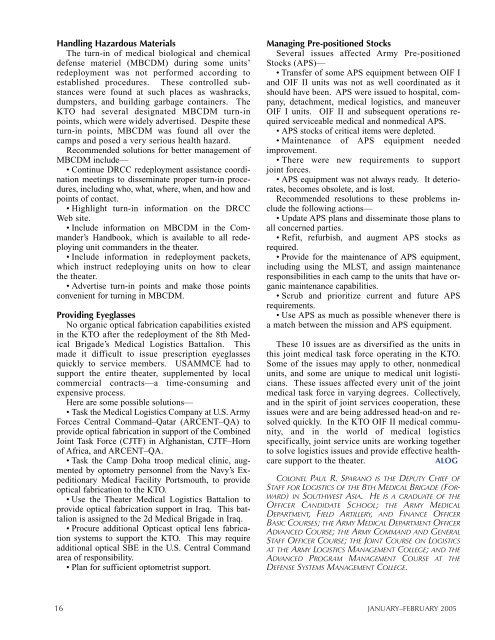Supporting the First Stryker Brigade in Iraq - Army Logistics ...
Supporting the First Stryker Brigade in Iraq - Army Logistics ...
Supporting the First Stryker Brigade in Iraq - Army Logistics ...
You also want an ePaper? Increase the reach of your titles
YUMPU automatically turns print PDFs into web optimized ePapers that Google loves.
Handl<strong>in</strong>g Hazardous Materials<br />
The turn-<strong>in</strong> of medical biological and chemical<br />
defense materiel (MBCDM) dur<strong>in</strong>g some units’<br />
redeployment was not performed accord<strong>in</strong>g to<br />
established procedures. These controlled substances<br />
were found at such places as washracks,<br />
dumpsters, and build<strong>in</strong>g garbage conta<strong>in</strong>ers. The<br />
KTO had several designated MBCDM turn-<strong>in</strong><br />
po<strong>in</strong>ts, which were widely advertised. Despite <strong>the</strong>se<br />
turn-<strong>in</strong> po<strong>in</strong>ts, MBCDM was found all over <strong>the</strong><br />
camps and posed a very serious health hazard.<br />
Recommended solutions for better management of<br />
MBCDM <strong>in</strong>clude—<br />
• Cont<strong>in</strong>ue DRCC redeployment assistance coord<strong>in</strong>ation<br />
meet<strong>in</strong>gs to dissem<strong>in</strong>ate proper turn-<strong>in</strong> procedures,<br />
<strong>in</strong>clud<strong>in</strong>g who, what, where, when, and how and<br />
po<strong>in</strong>ts of contact.<br />
• Highlight turn-<strong>in</strong> <strong>in</strong>formation on <strong>the</strong> DRCC<br />
Web site.<br />
• Include <strong>in</strong>formation on MBCDM <strong>in</strong> <strong>the</strong> Commander’s<br />
Handbook, which is available to all redeploy<strong>in</strong>g<br />
unit commanders <strong>in</strong> <strong>the</strong> <strong>the</strong>ater.<br />
• Include <strong>in</strong>formation <strong>in</strong> redeployment packets,<br />
which <strong>in</strong>struct redeploy<strong>in</strong>g units on how to clear<br />
<strong>the</strong> <strong>the</strong>ater.<br />
• Advertise turn-<strong>in</strong> po<strong>in</strong>ts and make those po<strong>in</strong>ts<br />
convenient for turn<strong>in</strong>g <strong>in</strong> MBCDM.<br />
Provid<strong>in</strong>g Eyeglasses<br />
No organic optical fabrication capabilities existed<br />
<strong>in</strong> <strong>the</strong> KTO after <strong>the</strong> redeployment of <strong>the</strong> 8th Medical<br />
<strong>Brigade</strong>’s Medical <strong>Logistics</strong> Battalion. This<br />
made it difficult to issue prescription eyeglasses<br />
quickly to service members. USAMMCE had to<br />
support <strong>the</strong> entire <strong>the</strong>ater, supplemented by local<br />
commercial contracts—a time-consum<strong>in</strong>g and<br />
expensive process.<br />
Here are some possible solutions—<br />
• Task <strong>the</strong> Medical <strong>Logistics</strong> Company at U.S. <strong>Army</strong><br />
Forces Central Command–Qatar (ARCENT–QA) to<br />
provide optical fabrication <strong>in</strong> support of <strong>the</strong> Comb<strong>in</strong>ed<br />
Jo<strong>in</strong>t Task Force (CJTF) <strong>in</strong> Afghanistan, CJTF–Horn<br />
of Africa, and ARCENT–QA.<br />
• Task <strong>the</strong> Camp Doha troop medical cl<strong>in</strong>ic, augmented<br />
by optometry personnel from <strong>the</strong> Navy’s Expeditionary<br />
Medical Facility Portsmouth, to provide<br />
optical fabrication to <strong>the</strong> KTO.<br />
• Use <strong>the</strong> Theater Medical <strong>Logistics</strong> Battalion to<br />
provide optical fabrication support <strong>in</strong> <strong>Iraq</strong>. This battalion<br />
is assigned to <strong>the</strong> 2d Medical <strong>Brigade</strong> <strong>in</strong> <strong>Iraq</strong>.<br />
• Procure additional Opticast optical lens fabrication<br />
systems to support <strong>the</strong> KTO. This may require<br />
additional optical SBE <strong>in</strong> <strong>the</strong> U.S. Central Command<br />
area of responsibility.<br />
• Plan for sufficient optometrist support.<br />
16<br />
Manag<strong>in</strong>g Pre-positioned Stocks<br />
Several issues affected <strong>Army</strong> Pre-positioned<br />
Stocks (APS)—<br />
• Transfer of some APS equipment between OIF I<br />
and OIF II units was not as well coord<strong>in</strong>ated as it<br />
should have been. APS were issued to hospital, company,<br />
detachment, medical logistics, and maneuver<br />
OIF I units. OIF II and subsequent operations required<br />
serviceable medical and nonmedical APS.<br />
• APS stocks of critical items were depleted.<br />
• Ma<strong>in</strong>tenance of APS equipment needed<br />
improvement.<br />
• There were new requirements to support<br />
jo<strong>in</strong>t forces.<br />
• APS equipment was not always ready. It deteriorates,<br />
becomes obsolete, and is lost.<br />
Recommended resolutions to <strong>the</strong>se problems <strong>in</strong>clude<br />
<strong>the</strong> follow<strong>in</strong>g actions—<br />
• Update APS plans and dissem<strong>in</strong>ate those plans to<br />
all concerned parties.<br />
• Refit, refurbish, and augment APS stocks as<br />
required.<br />
• Provide for <strong>the</strong> ma<strong>in</strong>tenance of APS equipment,<br />
<strong>in</strong>clud<strong>in</strong>g us<strong>in</strong>g <strong>the</strong> MLST, and assign ma<strong>in</strong>tenance<br />
responsibilities <strong>in</strong> each camp to <strong>the</strong> units that have organic<br />
ma<strong>in</strong>tenance capabilities.<br />
• Scrub and prioritize current and future APS<br />
requirements.<br />
• Use APS as much as possible whenever <strong>the</strong>re is<br />
a match between <strong>the</strong> mission and APS equipment.<br />
These 10 issues are as diversified as <strong>the</strong> units <strong>in</strong><br />
this jo<strong>in</strong>t medical task force operat<strong>in</strong>g <strong>in</strong> <strong>the</strong> KTO.<br />
Some of <strong>the</strong> issues may apply to o<strong>the</strong>r, nonmedical<br />
units, and some are unique to medical unit logisticians.<br />
These issues affected every unit of <strong>the</strong> jo<strong>in</strong>t<br />
medical task force <strong>in</strong> vary<strong>in</strong>g degrees. Collectively,<br />
and <strong>in</strong> <strong>the</strong> spirit of jo<strong>in</strong>t services cooperation, <strong>the</strong>se<br />
issues were and are be<strong>in</strong>g addressed head-on and resolved<br />
quickly. In <strong>the</strong> KTO OIF II medical community,<br />
and <strong>in</strong> <strong>the</strong> world of medical logistics<br />
specifically, jo<strong>in</strong>t service units are work<strong>in</strong>g toge<strong>the</strong>r<br />
to solve logistics issues and provide effective healthcare<br />
support to <strong>the</strong> <strong>the</strong>ater. ALOG<br />
COLONEL PAUL R. SPARANO IS THE DEPUTY CHIEF OF<br />
STAFF FOR LOGISTICS OF THE 8TH MEDICAL BRIGADE (FOR-<br />
WARD) IN SOUTHWEST ASIA. HE IS A GRADUATE OF THE<br />
OFFICER CANDIDATE SCHOOL; THE ARMY MEDICAL<br />
DEPARTMENT, FIELD ARTILLERY, AND FINANCE OFFICER<br />
BASIC COURSES; THE ARMY MEDICAL DEPARTMENT OFFICER<br />
ADVANCED COURSE; THE ARMY COMMAND AND GENERAL<br />
STAFF OFFICER COURSE; THE JOINT COURSE ON LOGISTICS<br />
AT THE ARMY LOGISTICS MANAGEMENT COLLEGE; AND THE<br />
ADVANCED PROGRAM MANAGEMENT COURSE AT THE<br />
DEFENSE SYSTEMS MANAGEMENT COLLEGE.<br />
JANUARY–FEBRUARY 2005







